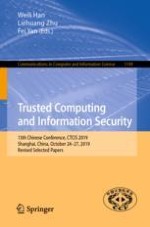2020 | Book
Trusted Computing and Information Security
13th Chinese Conference, CTCIS 2019, Shanghai, China, October 24–27, 2019, Revised Selected Papers
Editors: Weili Han, Prof. Liehuang Zhu, Fei Yan
Publisher: Springer Singapore
Book Series : Communications in Computer and Information Science
